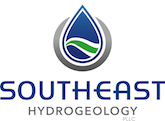
Looking up locations by address is as easy as typing the address into the search bar and hitting return. Placemarks can be used to mark locations and these placemarks can be distinguished by different icons and colors. You can even add your own custom icons for your placemarks. Your placemarks are stored in the program, so they will be there the next time you open Google Earth. Various notes can be added to these placemarks for further reference. Each placemark will also have a latitude and longitude listed for it, making well locations for state well logs easy to do.
Probably the most useful aspect of Google Earth is the ability to add overlay layers. These layers will be files with either the extension .kml or .kmz, which will open directly into Google Earth. There are many layers available that have been created by others or you can create your own. Two of these layers that I use in my work as a water resources consultant are topographic maps of the entire United States and digital state geologic maps, which are both extremely useful in locating water wells.
Links to download the Google Earth software, topographic map layers and state geologic map layers are listed below:
Google Earth software download: https://www.google.com/earth/
Google Earth topographic maps layer: http://www.earthpoint.us/TopoMap.aspx
Google Earth State Geology Maps: https://mrdata.usgs.gov/geology/state/
